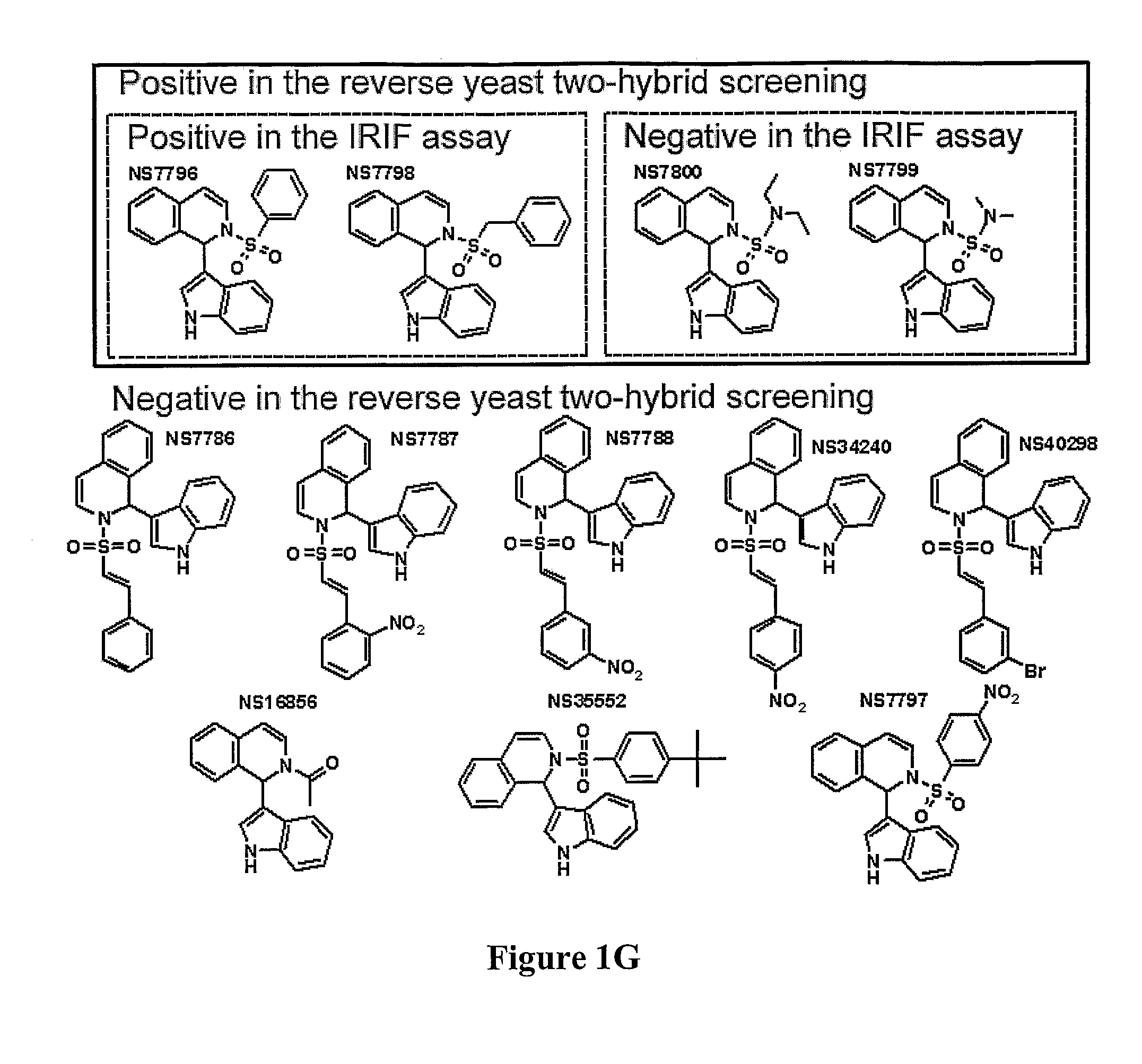Compositions and methods for disruption of BRCA2-Rad51 interaction
a technology of brca2 and interaction, applied in the field of rad51 and brca2, can solve the problems of non-neoplastic cells failing to proceed to s-phase and achieve the effects of reducing the binding of brca2 and increasing the sensitivity of neoplastic cells
- Summary
- Abstract
- Description
- Claims
- Application Information
AI Technical Summary
Benefits of technology
Problems solved by technology
Method used
Image
Examples
example 1
[0087]
[0088]2-(benzylsulfonyl)-1-(1H-indol-3-yl)-1,2-dihydroisoquinoline (IBR2): Isoquinoline (10.3 g, 80 mmol) was dissolved in anhydrous benzene (140 ml). α-phenylmethylsulphonyl chloride (7.64 g, 40 mmol) was added in portions. The reaction mixture was stirred at room temperature for 30 min. Indole (4.68 g, 40 mmol) was added and the reaction was continued at room temperature for 20 hr. During the reaction, a light-colored precipitation formed. Then the solid was collected and washed with toluene and hexane (50 ml each). The resulting crude product was further purified using flash chromatography (silica gel, 100% dichloromethane), yielding 11.1 g (97.5%) as a light yellow solid. The product (6.0 g) was further purified by recrystallization from ethanol (200 ml), to give a final product (5.7 g) as a white powder.
[0089]MS (m / e): 423.05 (M+Na+). 1HNMR (500 MHz, δ / ppm): 4.00 (d, 1H, J=13.88 Hz), 4.16 (d, 1H, J=13.92 Hz), 6.06 (d, 1H, J=7.53 Hz), 6.30 (d, 1H, J=7.45 Hz), 6.37 (s, 1H),...
example 2
[0090]Following the procedure of Example 1, 0.25 mmole of the optionally substituted indole was treated with 0.5 mmole of an optionally substituted isoquinoline and 0.25 mmol of α-phenylmethylsulphonyl chloride to yield substituted 2(benzylsulfonyl)-1-(1H-indol-3-yl)-1,2-dihydroisoquinolines, which are shown in the table immediately below (yields were derived from a single experiment and were not optimized).
[0091]
%RR1R2R3R4R5R6R7R8R9R10R11R14mgYieldBenzylHHHOMeHHHHHHHH34.8133BenzylHBrHHHHHHHHHH37.6832BenzylHHHHBrHHHHHHH91.8578BenzylHHHCOOMeHHHHHHHH30.3827BenzylHHHNH2HHHHHHHH55.9655BenzylHHHBrHHHHHHHH32.9728BenzylHHHHHHHHHHMe73.0872BenzylHHHNHAcHHHHHHH30.3127BenzylHHHNHCOPhHHHHHHH63.8850BenzylCOOEtHHHHHHHHHHH35.9631BenzylHHHHHHHHHBrHH37.6832BenzylHHHHBrHHHHBrHH7756BenzylHHHBrHHHHHBrHH38.528BenzylHHHOMeHHHHHBrHH35.0728BenzylHHHCOOMeHHHHHBrHH33.0625
example 3
[0092]2(benzylsulfonyl)-1-(7-aza-1H-indol-3-yl)-1,2-dihydroisoquinoline: Following the procedure of Example 1, 29.54 mg (0.25 mmol) of 7-azaindole was treated with 64.58 mg (0.5 mmole) of isoquinoline and 47.67 mg (0.25 mmol) of α-phenylmethylsulphonyl chloride to yield 58.95 mg (60% Yield) of 2(benzylsulfonyl)-1-(7-aza-1H-indol-3-yl)-1,2-dihydroisoquinoline.
PUM
| Property | Measurement | Unit |
|---|---|---|
| total volume | aaaaa | aaaaa |
| flow rate | aaaaa | aaaaa |
| total volume | aaaaa | aaaaa |
Abstract
Description
Claims
Application Information
 Login to View More
Login to View More - R&D
- Intellectual Property
- Life Sciences
- Materials
- Tech Scout
- Unparalleled Data Quality
- Higher Quality Content
- 60% Fewer Hallucinations
Browse by: Latest US Patents, China's latest patents, Technical Efficacy Thesaurus, Application Domain, Technology Topic, Popular Technical Reports.
© 2025 PatSnap. All rights reserved.Legal|Privacy policy|Modern Slavery Act Transparency Statement|Sitemap|About US| Contact US: help@patsnap.com



